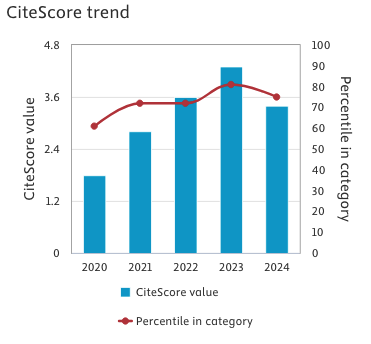Gestational age-dependent changes in human ductus arteriosus: A cadaveric histomorphometric and developmental analysis
Keywords:
Ductus arteriosus, fetal development, morphometry, histology, prenatal diagnosticsAbstract
Background and aim: The ductus arteriosus (DA) is a critical vascular structure in fetal circulation, shunting blood from the pulmonary artery to the aorta. The study investigates the histomorphometric characteristics of the ductus arteriosus (DA) in human fetuses, exploring its developmental changes across gestational ages.
Methods: This cross-sectional observational study examined 20 human fetal cadavers ranging from 17 to 37 weeks gestation, stratified into two groups: Group I (17th-24th week, n=10) and Group II (25th-37th week, n=10). Gross morphometric analysis included measurements of DA length, diameter at aortic and pulmonary ends, and angular orientation relative to the aorta. Histological examination involved H&E staining, with quantitative analysis of tunica media thickness.
Results: Gross anatomical measurements showed significant growth of DA from Group I to Group II. Angular measurements showed more modest changes, with the upstream angle increasing from 52.9° ± 3.5° to 61.0° ± 4.8° and downstream angle from 92.9° ± 7.9° to 103.8° ± 5.2°, exhibiting weak correlations with gestational age. Histologically, DA demonstrated a typical muscular artery structure. Group II fetuses exhibited more prominent internal and external elastic laminae. The tunica media showed notable differences, with Group I displaying a predominance of fibroblasts, while Group II fetuses had a thicker tunica media with more organized concentric lamellae.
Conclusions: The relative stability of DA's angular orientation suggests evolutionary optimization of fetal hemodynamics. The progressive organization and thickening of the tunica media, along with the development of elastic laminae, indicate a structural maturation process likely underpinning the DA's functional capabilities.
References
1. Schneider DJ, Moore JW. Patent ductus arteriosus. Circulation. 2006;114(17):1873–82. doi: 10.1161/circulationaha.105.592063
2. Coceani F, Baragatti B. Mechanisms for ductus arteriosus closure. Semin Perinatol. 2012;36(2):92–7. doi: 10.1053/j.semperi.2011.09.018
3. Stoller JZ, Demauro SB, Dagle JM, Reese J. Current perspectives on pathobiology of the ductus arteriosus. J Clin Exp Cardiolog. 2012;8(1):S8-001. doi: 10.4172/2155-9880.S8-001
4. Elumalai G, Ebami TU. Patent ductus arteriosus embryological basis and its clinical significance. Elixir Embryol. 2016;100:43433–8.
5. Gittenberger-de Groot AC, Strengers JL, Mentink M, Poelmann RE, Patterson DF. Histologic studies on normal and persistent ductus arteriosus in the dog. J Am Coll Cardiol. 1985;6(2):394–404. doi: 10.1016/s0735-1097(85)80178-9
6. Yokoyama U, Minamisawa S, Ishikawa Y. Regulation of vascular tone and remodeling of the ductus arteriosus. J Smooth Muscle Res. 2010;46(2):77–87. doi: 10.1540/jsmr.46.77
7. Brezinka C. Fetal ductus arteriosus—how far may it bend? Ultrasound Obstet Gynecol. 1995;6(1):6–7. doi: 10.1046/j.1469-0705.1995.06010004-2.x
8. Bökenkamp R, Deruiter MC, van Munsteren C, Gittenberger-de Groot AC. Insights into the pathogenesis and genetic background of patency of the ductus arteriosus. Neonatology. 2010;98(1):6–17. doi: 10.1159/000262481
9. Szyszka-Mróz J, Woźniak W. A histological study of human ductus arteriosus during the last embryonic week. Folia Morphol (Warsz). 2003;62(4):365–7.
10. Clyman RI. Mechanisms regulating the ductus arteriosus. Biol Neonate. 2006;89(4):330–5. doi: 10.1159/000092870
11. Benitz WE, Committee on Fetus and Newborn, American Academy of Pediatrics. Patent ductus arteriosus in preterm infants. Pediatrics. 2016;137(1):e20153730. doi: 10.1542/peds.2015-3730
12. Enzensberger C, Wienhard J, Weichert J, et al. Idiopathic constriction of the fetal ductus arteriosus: three cases and review of the literature. J Ultrasound Med. 2012;31(8):1285–91. doi: 10.7863/jum.2012.31.8.1285
13. Hamrick SEG, Sallmon H, Rose AT, et al. Patent ductus arteriosus of the preterm infant. Pediatrics. 2020;146(5):e20201209. doi: 10.1542/peds.2020-1209
14. Vettukattil JJ. Pathophysiology of patent ductus arteriosus in the preterm infant. Curr Pediatr Rev. 2016;12(2):120–2. doi: 10.2174/157339631202160506002215
15. Boudreau N, Clausell N, Boyle J, Rabinovitch M. Transforming growth factor-beta regulates increased ductus arteriosus endothelial glycosaminoglycan synthesis and a post-transcriptional mechanism controls increased smooth muscle fibronectin, features associated with intimal proliferation. Lab Invest. 1992;67(3):350–9.
16. Mielke G, Benda N. Reference ranges for two-dimensional echocardiographic examination of the fetal ductus arteriosus. Ultrasound Obstet Gynecol. 2000;15(3):219–25. doi: 10.1046/j.1469-0705.2000.00078.x
17. Prsa M, Sun L, van Amerom J, et al. Reference ranges of blood flow in the major vessels of the normal human fetal circulation at term by phase-contrast magnetic resonance imaging. Circ Cardiovasc Imaging. 2014;7(4):663–70. doi: 10.1161/circimaging.113.001859
18. Tada T, Kishimoto H. Ultrastructural and histological studies on closure of the mouse ductus arteriosus. Acta Anat (Basel). 1990;139(4):326–34. doi: 10.1159/000147020
19. Szpinda M, Szwesta A, Szpinda E. Morphometric study of the ductus arteriosus during human development. Ann Anat. 2007;189(1):47–52. doi: 10.1016/j.aanat.2006.06.008
20. Kugananthan M, Rao R, Ganapathy N. Histological study on the obliteration process of ductus arteriosus in still born fetuses. IOSR J Dent Med Sci. 2014;13(7):28–31.
21. Nowak D, Pruszko M, Walecka A. Diameter of the ductus arteriosus as a predictor of patent ductus arteriosus (PDA). Cent Eur J Med. 2011;6(4):418–24.
22. Brezinka C, Deruiter M, Slomp J, den Hollander N, Wladimiroff JW, Gittenberger-de Groot AC. Anatomical and sonographic correlation of the fetal ductus arteriosus in first and second trimester pregnancy. Ultrasound Med Biol. 1994;20(3):219–24. doi: 10.1016/0301-5629(94)90061-2
23. Gittenberger-de Groot AC, van Ertbruggen I, Moulaert AJ, Harinck E. The ductus arteriosus in the preterm infant: histologic and clinical observations. J Pediatr. 1980;96(1):88–93. doi: 10.1016/s0022-3476(80)80337-4
24. Slomp J, van Munsteren JC, Poelmann RE, de Reeder EG, Bogers AJ, Gittenberger-de Groot AC. Formation of intimal cushions in the ductus arteriosus as a model for vascular intimal thickening. An immunohistochemical study of changes in extracellular matrix components. Atherosclerosis. 1992;93(1–2):25–39. doi: 10.1016/0021-9150(92)90197-o
Downloads
Published
How to Cite
Issue
Section
License
Copyright (c) 2025 Purnima Adhikari, Rohini Punja, Sneha Guruprasad Kalthur

This work is licensed under a Creative Commons Attribution-NonCommercial 4.0 International License.
This is an Open Access article distributed under the terms of the Creative Commons Attribution License (https://creativecommons.org/licenses/by-nc/4.0) which permits unrestricted use, distribution, and reproduction in any medium, provided the original work is properly cited.
Transfer of Copyright and Permission to Reproduce Parts of Published Papers.
Authors retain the copyright for their published work. No formal permission will be required to reproduce parts (tables or illustrations) of published papers, provided the source is quoted appropriately and reproduction has no commercial intent. Reproductions with commercial intent will require written permission and payment of royalties.






